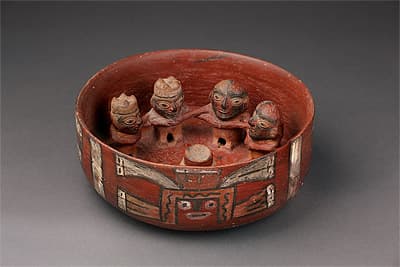
NAZCA-HUARI culture South coast 500 – 800 AD
Vessel with dancers 500-800 AD ceramic9.3 (h) x 24.2 (w) cm Ministerio de Cultura del Perú: Museo Nacional de Arqueología, Antropología e Historia del Perú, Photograph: Daniel Giannoni
The bowl is inhabited by dancers wearing hats, four with their arms interlinked. Its ritual use is underlined by a fearsome deity head and headdress painted onto the outside. The ceramic seems to fit into the period when the Nazca culture was being overtaken by the expansion of the Huari into the southern coastal valleys of Peru. It has been identified as Huari Pachacamac, dating from about the sixth to the eighth centuries.1
Christine Dixon
1. Luis Felipe Villacorta Ostolaza, Ceramics of ancient Peru / Cerámica del Perú antiguo, Lima: Gheller Doig 2007, p. 91.
The bowl is inhabited by dancers wearing hats, four with their arms interlinked. Its ritual use is underlined by a fearsome deity head and headdress painted onto the outside. The ceramic seems to fit into the period when the Nazca culture was being overtaken by the expansion of the Huari into the southern coastal valleys of Peru. It has been identified as Huari Pachacamac, dating from about the sixth to the eighth centuries.1
Christine Dixon
1. Luis Felipe Villacorta Ostolaza, Ceramics of ancient Peru / Cerámica del Perú antiguo, Lima: Gheller Doig 2007, p. 91.
The bowl is inhabited by dancers wearing hats, four with their arms interlinked. Its ritual use is underlined by a fearsome deity head and headdress painted onto the outside. The ceramic seems to fit into the period when the Nazca culture was being overtaken by the expansion of the Huari into the southern coastal valleys of Peru. It has been identified as Huari Pachacamac, dating from about the sixth to the eighth centuries.1
Christine Dixon
1. Luis Felipe Villacorta Ostolaza, Ceramics of ancient Peru / Cerámica del Perú antiguo, Lima: Gheller Doig 2007, p. 91.

